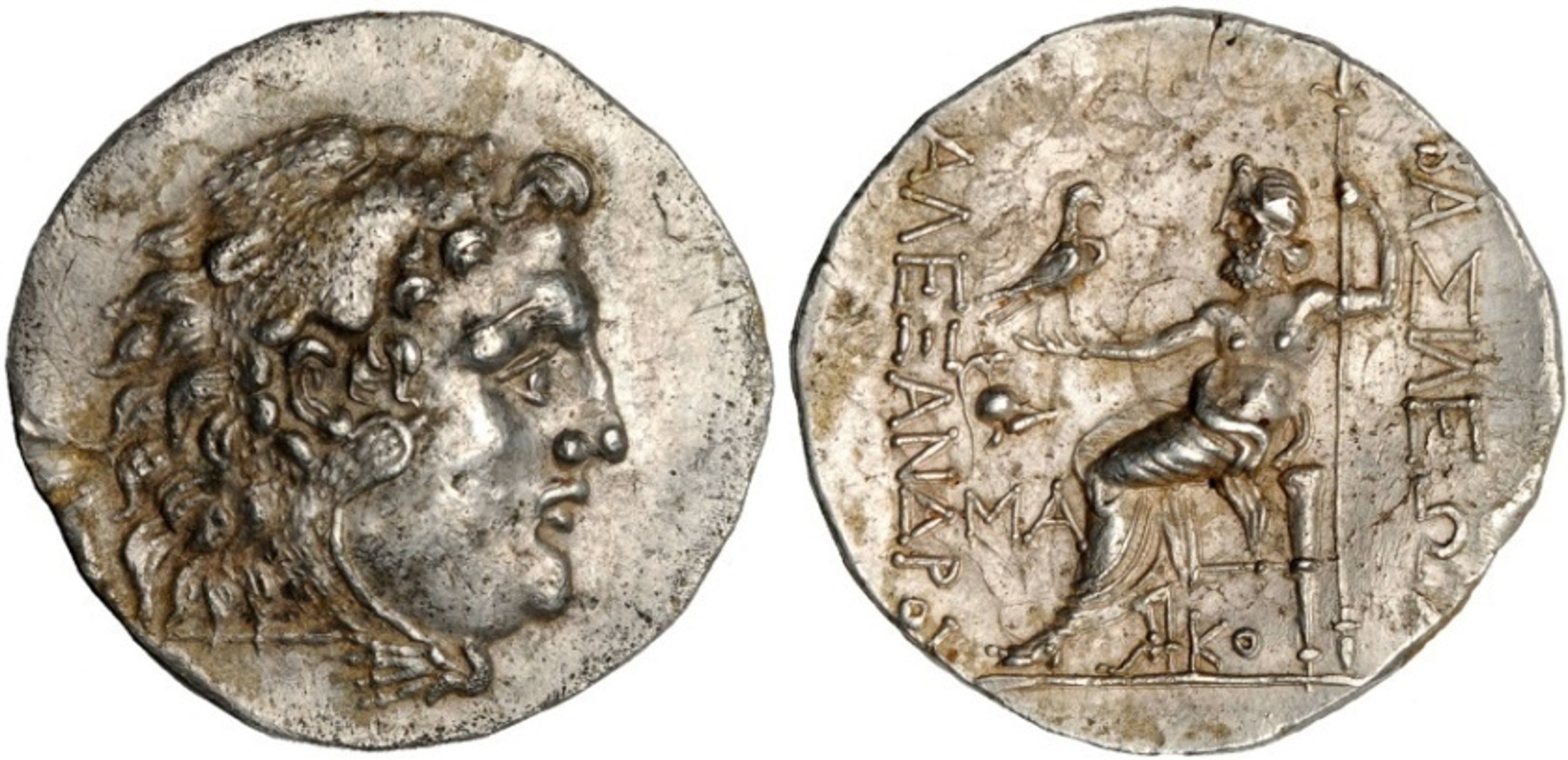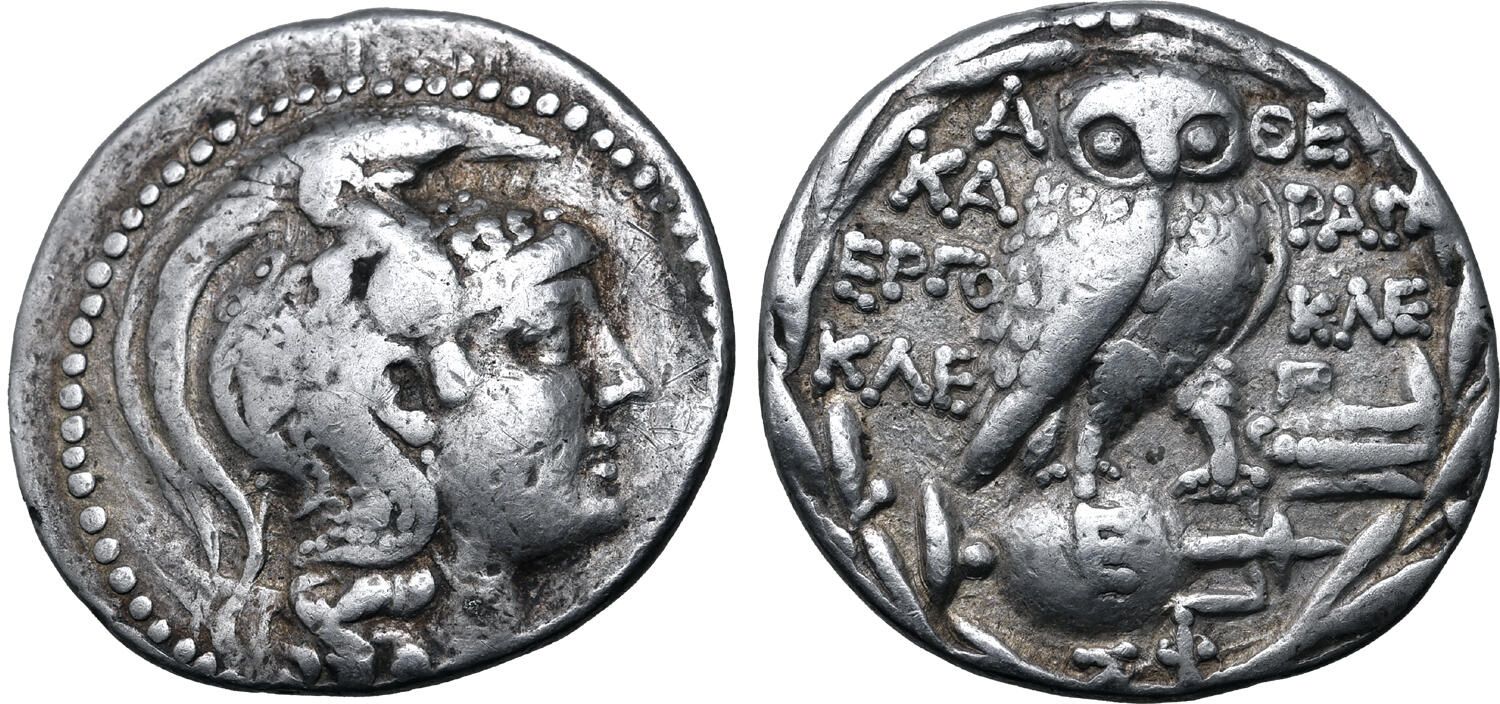3067 - Mesembria (Alexander the Great) (tetradrachm Heracles/Zeus) over Athens (Athena/owl) (Coin Galleries, July 2011, 954): Difference between revisions
From SILVER
(CSV import-Overstrikes-2022-08-16) |
m (Callatay moved page 840 - Mesembria (Alexander the Great) over Athens? (Coin Galleries, July 2011, 954) to 3067 - Mesembria (Alexander the Great) (tetradrachm Heracles/Zeus) over Athens (Athena/owl) (Coin Galleries, July 2011, 954)) |
||
| (7 intermediate revisions by 3 users not shown) | |||
| Line 1: | Line 1: | ||
{{Overstrike | {{Overstrike | ||
|Sale=Coin Galleries (07/07/2011), | |Image overstriking coin=SO 840 - Mesembria (Alexander the Great).jpg | ||
|Image overstruck variety=Athens KAPAIX EPΓỌKΛE.jpg | |||
|Sale=Coin Galleries (07/07/2011), lot 954. | |||
|Obverse description=Head of Herakles right, wearing lion skin headdress. | |Obverse description=Head of Herakles right, wearing lion skin headdress. | ||
|Reverse legend=BAΣΙΛΕΩΣ AΛΕΞANΔΡΟΥ | |Reverse legend=BAΣΙΛΕΩΣ AΛΕΞANΔΡΟΥ | ||
|Reverse description= Zeus enthroned left, holding eagle and scepter. Under the throne, KO. In left field, Corinthian crested helmet and MA. | |Reverse legend language=Greek | ||
|Reverse description=Zeus enthroned left, holding eagle and scepter. Under the throne, KO. In left field, Corinthian crested helmet and MA. | |||
|Mint=Mesembria | |Mint=Mesembria | ||
|Ancient region=Thrace | |Ancient region=Thrace | ||
|Authority=Alexander III the Great (Argead king, 336-323 BC | |Authority=Alexander III the Great (Argead king, 336-323 BC) | ||
|Date from= | |Date from=130 BCE | ||
|Date to= | |Date to=90 BCE | ||
|Period=hellenistic | |Period=hellenistic | ||
|Weight=16 | |Metal=Silver | ||
|Denomination= | |Weight=16.66 | ||
|Denomination=tetradrachm | |||
|Standard=Attic | |Standard=Attic | ||
|Coin series reference= | |Coin series reference=Price 1991, n°1077 ; Karayotov 1994, n° 347 (O49/R160) | ||
|Coin series web reference=http://numismatics.org/pella/id/price.1077 | |||
|Overstruck reverse description=(visible: Α and eyes of the owl in the upper field, part of the olive wreath in the inner right field). | |Overstruck reverse description=(visible: Α and eyes of the owl in the upper field, part of the olive wreath in the inner right field). | ||
|Overstruck mint=Athens | |Overstruck mint=Athens | ||
|Overstruck ancient region=Attica | |Overstruck ancient region=Attica | ||
|Overstruck date from=166 BCE | |||
|Overstruck date to=70 BCE | |||
|Overstruck period=Hellenistic | |||
|Overstruck denomination=tetradrachm | |Overstruck denomination=tetradrachm | ||
|Overstruck standard=Attic | |||
|Coin series reference overstruck=Thompson 1961 | |||
|Frequency of overstrikes=frequent | |||
|Level of confidence=weak | |||
}} | }} | ||
Latest revision as of 08:29, 14 November 2023
130 BCE - 90 BCE | BAΣΙΛΕΩΣ AΛΕΞANΔΡΟΥ
Location/history
| Sale(s)Sale(s) ᵖ: | Coin Galleries (07/07/2011), lot 954. | |
Overstriking coin
Description
| ObverseInscription or printing placed on the obverse.: | Head of Herakles right, wearing lion skin headdress. | ReverseInscription or printing placed on the reverse.: | BAΣΙΛΕΩΣ AΛΕΞANΔΡΟΥ (Greek) Zeus enthroned left, holding eagle and scepter. Under the throne, KO. In left field, Corinthian crested helmet and MA. |
Mint and issuing power
| MintIdentifies the place of manufacture or issue of a numismatic object.: | Mesembria | Ancient regionAncient region. | Thrace | Modern countryModern country: Bulgaria | AuthorityIdentifies the issuing power. The authority can be "pretended" when the name or the portrait of X is on the coin but he/she was not the issuing power. It can also be "uncertain" when there is no mention of X on the coin but he/she was the issuing power according to the historical sources: | Alexander III the Great (Argead king, 336-323 BC) |
Chronology
| FromIdentifies the initial date in a range assigned in a numismatic context. 130 BCE toIdentifies the final date in a range assigned in a numismatic context.. 90 BCE | hellenistic periodTime period of the numismatic object. |
Physical description
| MetalThe physical material (usually metal) from which an object is made.: Silver |
WeightWeight of the numismatic object (in grams). in grams: 16.6616.66 g <br />16,660 mg <br /> | DenominationTerm indicating the value of a numismatic object. Examples: tetradrachm, chalkous, denarius.: tetradrachm |
|
| StandardStandard.: Attic | |||
References
| Coin referenceReference of the Coin: | Coin series referenceReference to coin series study: | Price 19911Price 1991, n°1077, Karayotov 19942Karayotov 1994, n° 347 (O49/R160) | |
| Coin series web referenceCoin series web references: | |||
Overstruck type
Description
| ObverseInscription or printing placed on the obverse.: | ReverseInscription or printing placed on the reverse.: | (visible: Α and eyes of the owl in the upper field, part of the olive wreath in the inner right field). |
Mint and issuing power
| MintIdentifies the place of manufacture or issue of a numismatic object. ᵖ: | Athens | Ancient regionAncient region. ᵖ | Attica | Modern countryModern country: Greece | AuthorityIdentifies the authority in whose name (explicitly or implicitly) a numismatic object was issued. ᵖ: |
Chronology
| FromIdentifies the initial date in a range assigned in a numismatic context. 166 BCE toIdentifies the final date in a range assigned in a numismatic context.. 70 BCE | Hellenistic 323-30 BC |
Physical description
| DenominationTerm indicating the value of a numismatic object. Examples: tetradrachm, chalkous, denarius. ᵖ: | tetradrachm |
StandardStandard. ᵖ: | Attic |
References
| Coin type referenceReference to coin series study ᵖ: | Thompson 19613Thompson 1961 |
Additional data
| Frequency of overstrikesFrequency of overstrikes: | frequent | Level of confidenceLevel of confidence of the identification: | weak |
| RemarksRemarks: | |||

